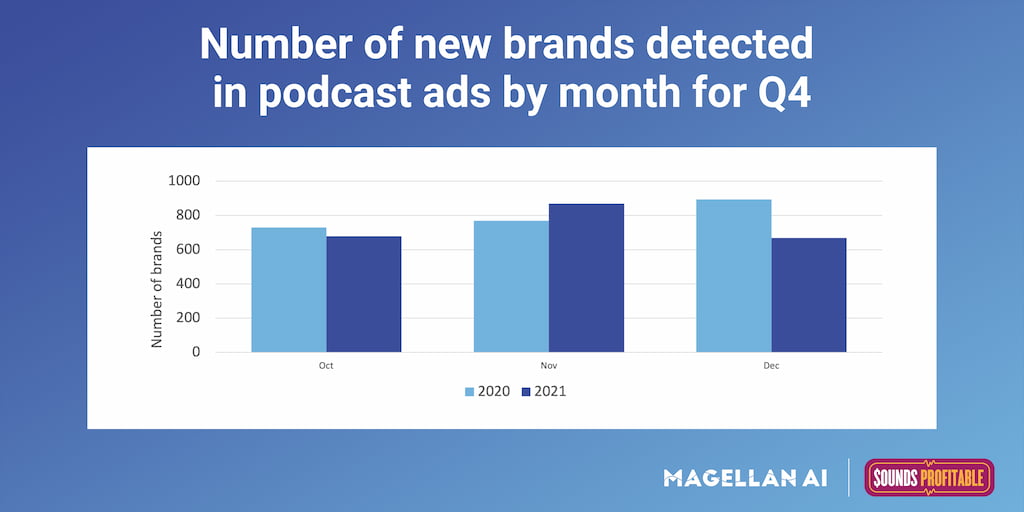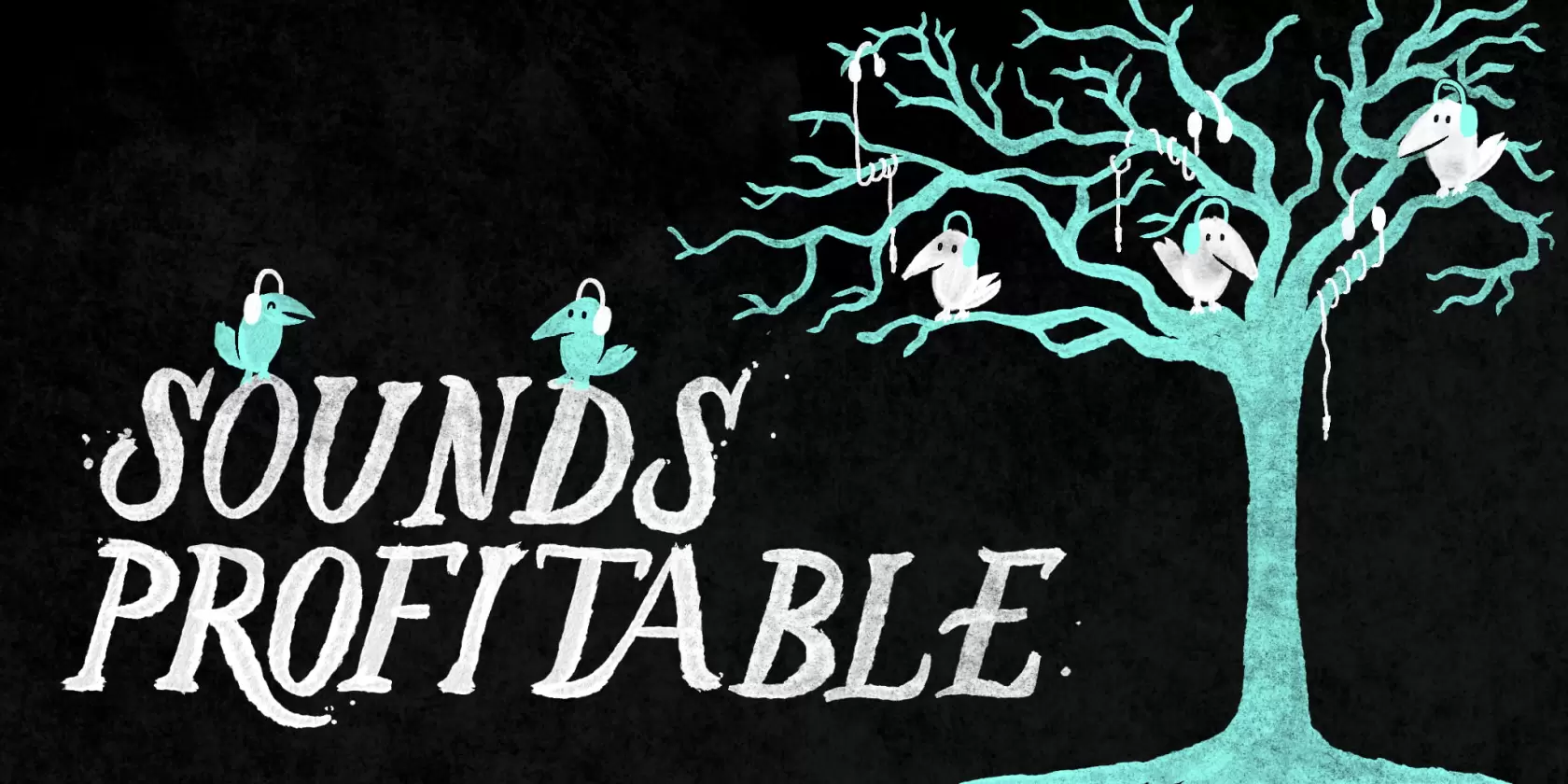Every Friday on the Sounds Profitable podcast, we release The Download, the most important business news from the world of podcasting. Check it out and let us know what you think!
Welcome to Good Data. In this monthly series from Sounds Profitable, we mine the latest audio industry studies and spotlight valuable insights. From audience behavior, revenue trends, programming opportunities, and promising platforms… #GoodData͏📊 is your quick and dirty rundown of the numbers that matter most in the pod biz. Caila Litman writes…
You’ve been in the meeting I’m talking about. There’s a white guy in a sports blazer. He’s pointing to a graph. He’s saying shit like “hockey stick growth” and “everything goes up and to the right.” Everybody nods enthusiastically. The c-suite in the room has a faint glint of dollar signs in their eyes. The takeaway: podcasting is really hot right now, bruh.
I hate to agree with sports blazer guy…but it’s true. The audio industry is poppin’. As one recent text from a friend weighing five different offers for a senior producer role put it, “I feel like it’s the 90s dot com boom and I’m a web developer.” Get it, girl.
With so much going on in the biz (and a new episode of Yellowjackets out), where are people finding the time to read fifty-seven page data dumps on listener behavior? We’re not all Tom Webster (a reality I mourn every day). And I guess that’s where I come into play.
My POV: Good Data = Powerful Storytelling
If you’ve worked in and around audio during the past few years, you likely have this swiss army knife mentality. From my experience, roles in audio inherently overlap with sales, marketing, product, and production functions. A prime example of this is the operational process of selling and setting a host read live. And if you work in this space, I’m sure you’ve been called upon to “tell the story” and “thread the needle” for folks wary of this new-fangled media channel. (Don’t get me started. It’s radio, Zeidy!)
My experience evangelizing audio within multi-channel, portfolio publishers has required lots of sifting through the latest podcast landscape reports to make compelling business cases. After countless SVPs have replied to my seven-paragraph emails with “k”, I know that one or two strong data points have the power to quickly convey even the most complex stories.
Enter: Good Data
You can think of Good Data as podcast numbers and what they mean, for friggin’ idiots. Okay…maybe it’s not that reductionist. I’ll read and re-read the latest audio industry studies, then I’ll disseminate the numbers – pointing out which indicators deserve the most attention. I’ll scrutinize measurement methodologies and poke holes in how a study should be weighed in a broader context. Beyond saving my friends in this industry time (since we’re all doing seventeen different jobs), I’m committed to giving you actionable insights – stuff that you can feel confident referencing in marketing decks or use to help inform business development strategies.
Where are the white spaces? What ad categories are spending the most? How is listening behavior evolving? Are there really no more “hits” in podcasting? What do these numbers even mean!?
By creating connective tissue between the various studies circulating in any given month, my hope is we unearth a clearer picture…maybe even wind up on the same wavelength? Pun intended.
Going Into 2022: What’s some Good Data to Know?
Now to the fun stuff. I spent the better half of December mining twenty-five industry podcast studies from 2021, hunting for the hottest stats worth our attention. Pretty cool, huh? That was rhetorical.
As we move into 2022, I want to examine data at the very heart of keeping the lights on in this industry: listener enthusiasm. What keeps people coming back for more podcasts? I plucked some valuable insights out of recent studies to help paint a more holistic picture of how audiences are still gravitating toward the medium with unprecedented enthusiasm.
Listener Enthusiasm: Is it Sustainable? The data indicates a hard yes.
At a high level, Spoken Word Audio consumption is consistently growing. Edison Research and NPR released The Spoken Word Audio Report back in November 2021, which reflected three powerful takeaways. Note: Spoken Word Audio may be abbreviated as SWA below.
- Spoken Word Audio consumption is experiencing massive and consistent audience growth:
– 75% of the US population listened to SWA in the past month
– 57% of the US population have listened to a podcast as of 2021, which is a new all-time high
– 176% increase in podcast’s share of time spent with SWA over the last seven years; with 16% growth in the last year
– 278% increase in share of time spent listening to SWA on a mobile device over the past seven years
– 45% of the US population listens to SWA daily in 2021; this is up by 2% YoY from 2020
– 40% increase in SWA consumption over the past seven years; the medium saw 8% growth in the last year alone.
– 22 million more people are listening to SWA today compared to seven years ago - New audiences are driving growth in Spoken Word Audio consumption: Listeners identifying as young, multicultural and women represent the largest growth in SWA consumption over the past seven years.
- More Women Listening
– 71% increase in women share of time spent listening to SWA vs 23% increase in men - Why is the increase in listeners identifying as women significant? Historically the podcast audience has been male-dominated. The recent growth in listeners identifying as women represents a programming opportunity for audio publishers looking to attract this rapidly growing listener base. Note: This study did not offer any data around consumption amongst folks identifying outside the gender binary.
- Younger Audience Growth
– 116% increase within SWA consumption in A13-34 vs 36% increase in A35-44 - Why is the A13-34 audience growth significant? Younger audiences expressing such a strong interest in SWA means publishers have a huge opportunity to cultivate affinity with this demographic by distributing to the platforms where they spend the most time – such as YouTube, Twitch, TikTok, Snapchat and more.
- In fact, if you’re not distributing your podcast to YouTube, you’re missing out on a powerful discovery engine that reaches a younger, deeply enthusiastic demo.
– 58% of listeners A18-34 report finding out about new SWA on YouTube or Twitch
– 13% of share of time spent listening to audio sources happens on YouTube (Q3 2021, Edison Share of Ear Study). - Increase in Multicultural Listeners
– 83% increase in African-American share of time spent listening to SWA in the past seven years
– 80% increase in Hispanic/Latino share of time spent listening to SWA in the past seven years
Note: I personally don’t love characterizing black folks in the US as “African-American” as it dismisses the black experience from non-African countries. However, this is how the study I pulled from referenced this demo and I’ll park my white guilt on this one. - Why the podcast industry needs to acknowledge the growing diversity of its audience: Representation will become increasingly important for legitimate audio publishers. A sea of white hosts, with white experiences, is tone-deaf AF in 2022. This should look like younger BIPOC folks working at every level within the industry. White suits hiring black and brown voices run the risk of tokenizing their perspectives. I’m hopeful that better representation is possible, specifically within the departments that make programming decisions. In future articles, we’ll better unpack the complexity of this data by exploring recent Black and Latino listener studies.
- More valuable than other mediums: Listeners are motivated to consume SWA programming (e.g. news, sports, talk/personalities, and audiobooks) because of its educational, self-improvement and perspective-shifting value.
- Reasons why monthly SWA listeners US A18+ said they listen:
– 71% listen to multitask
– 60% listen because it offers perspectives you don’t hear in other media
– 60% listen to better yourself
– 55% listen because of hosts they identity with
– 46% listen to continue their education
– 43% listen because it makes them feel less lonely
– 62% of SWA listeners A18-34 agree it engages their mind in a more positive way than other media
– 63% of SWA Multicultural listeners agree it engages their mind in a more positive way than other media
– 58% of all SWA listeners agree it’s a productive user of their time - Why should we pay attention to the “why” audiences consume audio-first content? Simple! In the attention economy, people will spend more time with content that adds immediate value to their lives. From more human connection in a deeply depressing era in human history, to more positivity and self-improvement opportunities – listener enthusiasm remains strong because audio delivers a spectrum of engaging human experiences.
I’ll also add: In conversations with new advertisers, skeptical of spending in audio, the more impactful sell is typically around what kind of value the medium adds to their target demo’s lives. It’s tremendously appealing to associate with a media channel that reaches a deeply aspirational and engaged audience.
But it’s not just Edison Research’s The Spoken Word Audio Report tracking this powerful listener enthusiasm. Back in early December 2021, a whole COVID variant ago, Acast released the results of its US Podcast Listening Landscape Study. Executed in partnership with Nielsen, the study surveyed 2,000 monthly podcast listeners A18+. Aiming to shed light on changing podcast consumption behavior and attitudes toward audio-first content experiences, the study proceeded to echo record-high listener enthusiasm. Here are a few gems from that sixty-seven page report:
- Podcast listeners are listening more:
– 52% said they increased their overall podcast consumption in the past 6-months
– 86% said they listen on a weekly or daily basis - Compared to other mediums, podcast listening is growing the most!
Survey participants reported spending more time with podcasts than any other medium – even other streaming audio, such as music (36%) and online radio (29%). - Why is this an important indicator? Audio publishers are fighting for the media ecosystem to pay attention to how consumers value podcasts compared to other mediums. With the endorsement of a reputable study, the numbers demonstrate how consumers are not only into pods, but 41% are planning to spend more time with them in the next 6-months.
- And why do consumers find podcasts more compelling than other mediums? With so much competition for our time, people are seeking an experience that adds value and depth.
– 71% of participants agreed that podcasts give deeper insight into people than other media channels - Access to net new audiences:
– 21% of listeners said they only began consuming podcasts in the last 6-months
– A18-34 is still the fastest-growing cohort of listeners – with 79% reporting that they listen multiple times a week
Finally, as I wrap this first issue of Good Data about the promise of listener enthusiasm, I want to cite some data points about audio’s impact on the cultural landscape from Spotify’s recent 2021 Culture Next Report. As depicted above, the future of audience engagement in audio will be about appealing to an emerging generation of power listeners – who are more diverse but just as aspirational as the OG audience. Caveating that the following study was conducted within Spotify’s closed ecosystem (a platform that has quickly overtaken other platforms as the listening destination of choice), the data is nonetheless worth elevating.
According to Spotify, listener enthusiasm for podcasts continues to drive the culture in new ways because podcasts inspire trust by educating, entertaining and informing audiences. Here are a few data points from this study, which further underscore the validity of the two reports above:
- Trust building – 40% of millennials and Gen Zs rank their trust in podcasts higher than their average trust in traditional media sources, including national TV news, newspapers, and radio
- Powerful storytelling devices
– 69% of millennials think audio formats like podcasts are one of the greatest ways to tell stories
– 61% of Gen Zs think audio formats like podcasts are one of the greatest ways to tell stories - Seeking diverse content creators
– 58% of millennials have sought content from more diverse creators in the last year
– 48% of Gen Zs have sought content from more diverse creators in the last year - Podcasts are a valuable resource
– 74% of millennials see audio as a mental health resource
– 62% of millennials use podcasts to learn about social issues
– 52% of Gen Zs use podcasts to learn about social issues
Thanks for taking the time to consider this data. Here’s a list of the studies referenced in this article:
- Edison Research and NPR | The Spoken Word Audio Report (November, 2021)
- Edison Research | Q3 2021 Share of Ear Study (October, 2021)
- Acast | US Podcast Listening Landscape Study (December, 2021)
- Spotify | 2021 Culture Next Report (2021)
New Sponsors
Sounds Profitable exists thanks to the continued support of our amazing sponsors. Each sponsor receives one hour of consulting per month as a way to say thanks.
- Sonnant removes the complexity of your content creation and delivery strategy with AI, transforming it so your content can flourish.
Want to learn more about sponsorship? Hit reply!
Rel’s Recs

Arielle Nissenblatt of Earbuds Podcast Collective this week has chosen Muriel’s Murders, from Campfire Media, hosted on Anchor.
Muriel and Nick, a husband and wife podcast pair, do a wonderful job of bringing true crime stories to life without sensationalizing the details. The most endearing aspect of this podcast is that Muriel is SO into the details while Nick seemingly has a weak stomach for them, so Muriel gently coaxes him along. As listeners, we enjoy both the telling of the tale at hand and the hosts’ relationship!
Market Insights with Magellan AI

Comparing Q4 2020 to Q 2021, the number of new brands detected in podcast ads was down 7%. However, when Magellan AI looked at the spend in the same period, the amount spent in Q4 2021 was more than double that of Q4 2020.
Join us Thursday at 11AM ET for an analysis of how December’s top spenders and top movers and shakers advertised through the holidays.
Anatomy of an Ad with ThoughtLeaders

What makes a good podcast ad? You know it when you hear it, sure. But is there more to it? We’ve teamed up with ThoughtLeaders to break down what works, what doesn’t, and what it takes to make great ads. This week they’ve focused on Gals on the Go‘s ad for BetterHelp. While the content alignment is perfect, the ad reads feel disconnected from the individual episode. Check out the analysis by ThoughtLeaders and let us know if you agree.


















































































































































































































